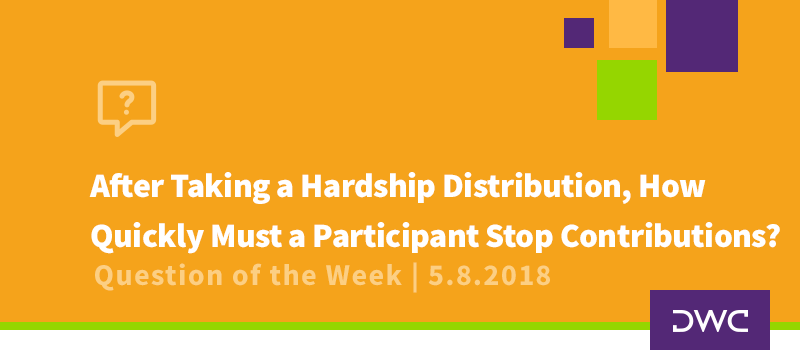Company Contribution Deposit Deadlines

The deadline for depositing employee salary deferrals into the plan is relatively straightforward; however, the same cannot be said for company contributions such as matching and profit sharing contributions. The main reason is that there are different rules depending on the purpose of the deadline. In other words, one set of regulations may specify one deadline for compliance purposes, but another set requires a different deadline for deduction purposes.
In this FAQ, we will review some of the different deadlines to try to help you make sense of them.
Tax Deductibility
When do we have to deposit company contributions in order to take them as a tax deduction for the year?
In order to deduct a contribution for a given year, it must be deposited by the due date (including extensions) of the company tax return.
For example, ABC Company is a calendar year tax filer. Its 2017 company return is due March 15, 2018, but can be extended to September 15th. If ABC does not extend the due date of the company return, it must deposit its contributions to the plan no later than March 15, 2018, in order to claim the deduction on its 2017 return. If ABC does extend, the deposit must be made no later than September 15th.
Does that mean that if the deposit is made after the due date of the tax return that it cannot be deducted?
Fortunately, no. The contribution is simply deducted on the subsequent year’s return. Using the above example, let’s assume that ABC did not extend its company return and has a filing deadline of March 15, 2018, but it cannot fund its profit sharing contribution until June. In that case, ABC would deduct the match on its 2018 return rather than for 2017. Keep in mind, however, that if ABC deposits its 2018 profit sharing contribution in time to deduct it on the 2018 return, it will need to make sure that the sum of the two years’ contributions due not exceed the deduction limit.
If we file the company return early, do we still have until the actual due date to make the deposit?
Yes. The deposit deadline is based on the due date (with extensions) of the tax return, not the date it is actually filed. However, it is important to note that to the extent the actual deposit is not made by the due date of the return or the amount of the deposit is different than anticipated, the company would need to file an amended return to adjust the deduction that was claimed. As a result, it is usually recommended that the deposit be made (or at least set aside) by the date of filing.
Plan Compliance
What is the latest date a company can deposit an employer contribution and still have it count against the overall limit for a given year?
The Annual Additions limit refers to the total amount of contributions that can be allocated to a participant’s account for a given limitation year. In most cases, the limitation year is the same as the plan year. In order for a company contribution to be treated as an annual addition for a given year, that contribution must be deposited no later than 30 days following the due date of the company tax return (with extensions).
Let’s assume our friends at ABC Company extend the deadline for the 2017 company tax return to September 15, 2018. The date by which they would need to deposit the profit sharing contribution in order for it to be treated as a 2017 annual addition is October 15, 2018, which is 30 days after the September 15th tax-filing deadline.
What about not-for-profit organizations that do not file a tax return? When are their company contributions due?
The regulations require the contributions to be deposited no later than the 15th day of the 10th month following the close of the year...October 15th for calendar year plans.
Rather than worrying about the latest possible date, can’t we deposit the company contribution throughout the year?
It depends on the plan’s provisions. Some plans require participants to meet certain conditions in order to share in the contribution for the year. Two of the more common allocation conditions are completion of at least 1,000 hours of service during the year and/or employment on the last day of the plan year. If your plan includes these types of requirements and you fund the contribution throughout the year, it is possible that some participants might not end up meeting the conditions. In other words, a contribution ends up being made for someone who is not entitled to it. Therefore, it is strongly recommended that plans with allocation conditions wait until the end of the year to deposit the contribution.
Are there any special deadlines for depositing the company contribution for a safe harbor 401(k) plan?
The safe harbor nonelective contribution (generally 3% of compensation for each participant) must be deposited no later than the last day of the plan year following the plan year to which it relates, e.g. December 31, 2018 for the 2017 safe harbor NEC.
For safe harbor match plans, the deposit deadline depends on how frequently the plan document requires the match to be calculated. If the match must be calculated based on full-year compensation and deferrals, it is subject to the same deposit deadline as the safe harbor NEC, described above. However, if it must be calculated any more frequently (such as each pay period), it must be deposited by the end of the next calendar quarter, i.e. by the end of the 3rd quarter for a match related to the 2nd quarter.
Do any other plan types have different deposit deadlines?
Although there aren’t many of them around anymore, contributions to money purchase pension plans and target benefit plans are generally required to be made no later than 8 ½ months following the close of the plan year, e.g. September 15th for a calendar year plan.
Certain nondiscrimination tests might require making additional contributions. Do those sorts of contributions have special deadlines?
For several testing-related contributions, the deposit deadline is the last day of the plan year following the plan year to which the contribution relates. These include minimum contributions for top heavy plans as well as QNECs or QMACs to correct a failed ADP/ACP test. In other words, a plan that fails the ADP test for the 2017 plan year would have until December 31, 2018, to deposit the corrective QNEC.
If a plan fails the minimum coverage test and must correct by retroactively amending the plan to increase benefits, the associated contributions must be made within 8 ½ months following the close of the plan year of the failure, e.g. September 15th for calendar year plans.
Keep in mind that these deadlines only apply to the correction of the nondiscrimination test in question. With very few exceptions, they do not change the deposit deadlines for other purposes such as deductibility and application of the contribution limits.
How do I keep up with all of these deadlines?
Simple. Just contact DWC. We monitor these deadlines for our clients and will identify any timing issues in particular need of attention in the annual compliance reports we provide. If you are not a DWC client or if you are considering changing the type or timing of company contributions, we are glad to talk through the situation with you.
For more information on plan sponsor deadlines and requirements, visit our Knowledge Center here.




















